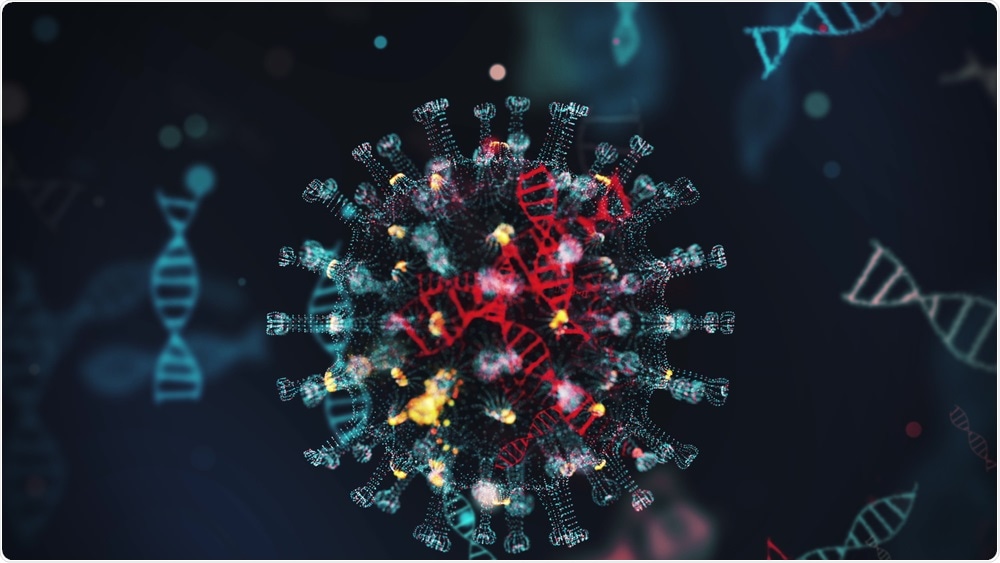The highly infectious nature of the severe acute respiratory syndrome coronavirus 2 (SARS-CoV-2) is largely due to its affinity for mutations that continue to evolve and emerge throughout the current coronavirus disease 2019 (COVID-19) pandemic.
 Study: The Functional Consequences of the Novel Ribosomal Pausing Site in SARS-CoV-2 Spike Glycoprotein RNA. Image Credit: CG Alex / Shutterstock.com
Study: The Functional Consequences of the Novel Ribosomal Pausing Site in SARS-CoV-2 Spike Glycoprotein RNA. Image Credit: CG Alex / Shutterstock.com
Several novel features of SARS-CoV-2 have been identified in newly circulating variants of this virus, such as those that affect the spike glycoprotein (S protein), which has acquired a 4 amino acid -PRRA- insertion sequence at amino acid residues 681-684. This specific mutation has resulted in the formation of a new furin cleavage site within the S protein, as well as three new adjacent glycosylation sites.
In a recent study published in the International Journal of Molecular Sciences journal, a group of researchers from the National Institutes of Health, in collaboration with the University of Maryland, discuss the functional implications of this specific S protein mutation on SARS-CoV-2.
The novel insertion
The development of effective therapeutic interventions and vaccines against SARS-CoV-2 has been heavily dependent upon understanding the structure of this virus. The S protein has been a primary point of interest for these endeavors, as this surface protein determines the entry of the virus into the host cell through endocytosis.
As SARS-CoV-2 has continued to spread throughout the world since its original discovery at the end of 2019, the S protein has acquired a novel four amino acid -PRRA- insertion sequence at amino acid residues 681-684. This addition has formed a new furin cleavage site in the S protein and three novel adjacent O-linked glycosylation sites. The importance of this mutation lies within the role of furin, which is abundant within the respiratory tract, as well as several other organs in the body.
The cleavage of furin is also important for other ribonucleic acid (RNA) viruses such as the human immunodeficiency virus (HIV) and Ebola to enter host cells. Notably, this new cleavage site has not previously been identified in any other type of coronavirus.
Translation of viral RNA
The translation of viral RNA is dependent on various factors such as translation frameshift site, which is commonly found in coronaviruses. Programmed ribosomal frameshifting is an essential mechanism that is used by human viruses like HIV and SARS that is critical for their replication.
Recently, researchers have suggested that programmed ribosomal frameshifting is dependent on ribosomal pausing. Ribosomal pausing can occur due to pause sites in some of the messenger-RNAs (mRNAs), which can cause disturbances to arise during the translation process. This pause allows for co-translational protein folding, protein targeting, and general protein interactions.
Programmed ribosomal frameshifting and ribosomal pausing are also believed to be dependent on codon usage bias, transfer-RNA (tRNA) abundance, and protein associations, all of which can affect RNA translation.
Significance for COVID-19
The current study investigated statistical properties of the novel -PRRA- insertion sequence at the RNA level because of the abnormal nucleotide composition and codon usage of this sequence.
These unusual features suggested that the insertion could cause ribosomal pausing. While the furin site is significant for the infectious capabilities of SARS-CoV-2, the ribosomal pausing can also play a role in modulating the expression levels of the spike protein.
Considerable genetic diversity was identified between the two variants of the -PRRA- sequence, which may be the result of positive selection of other positions within the S protein. This illustrates the importance of the insertion sequence and its ability to affect the translation of the virus. It was suggested that the -HRRA- variant that was identified in the B.1.1.7 strain, for example, may affect the pathogenesis and infectious level of this specific variant.
The researchers concluded that the value of their translational findings may be unclear; however, they support further research into antiviral therapies that promote amino acid synthesis through reducing fractions of rare tRNA codons that may be used to translate the viral protein. This would influence the insertion of overlapping translation pausing and furin sites that may increase SARS-CoV-2 infection rates.
- Postnikova, O. A., Uppal, S., Huang, W., et al. (2021). The Functional Consequences of the Novel Ribosomal Pausing Site in SARS-CoV-2 Spike Glycoprotein RNA. International Journal of Molecular Sciences, 22(12). doi:10.3390/ijms22126490. https://www.mdpi.com/1422-0067/22/12/6490.
Posted in: Medical Science News | Disease/Infection News | Healthcare News
Tags: Amino Acid, Cell, Codon, Coronavirus, Genetic, Glycoprotein, Glycosylation, HIV, Immunodeficiency, Mutation, Nucleotide, Pandemic, Protein, Protein Folding, Research, Respiratory, Ribonucleic Acid, RNA, SARS, SARS-CoV-2, Severe Acute Respiratory, Severe Acute Respiratory Syndrome, Spike Protein, Syndrome, Translation, Virus

Written by
Marzia Khan
Marzia Khan is a lover of scientific research and innovation. She immerses herself in literature and novel therapeutics which she does through her position on the Royal Free Ethical Review Board. Marzia has a MSc in Nanotechnology and Regenerative Medicine as well as a BSc in Biomedical Sciences. She is currently working in the NHS and is engaging in a scientific innovation program.
Source: Read Full Article
